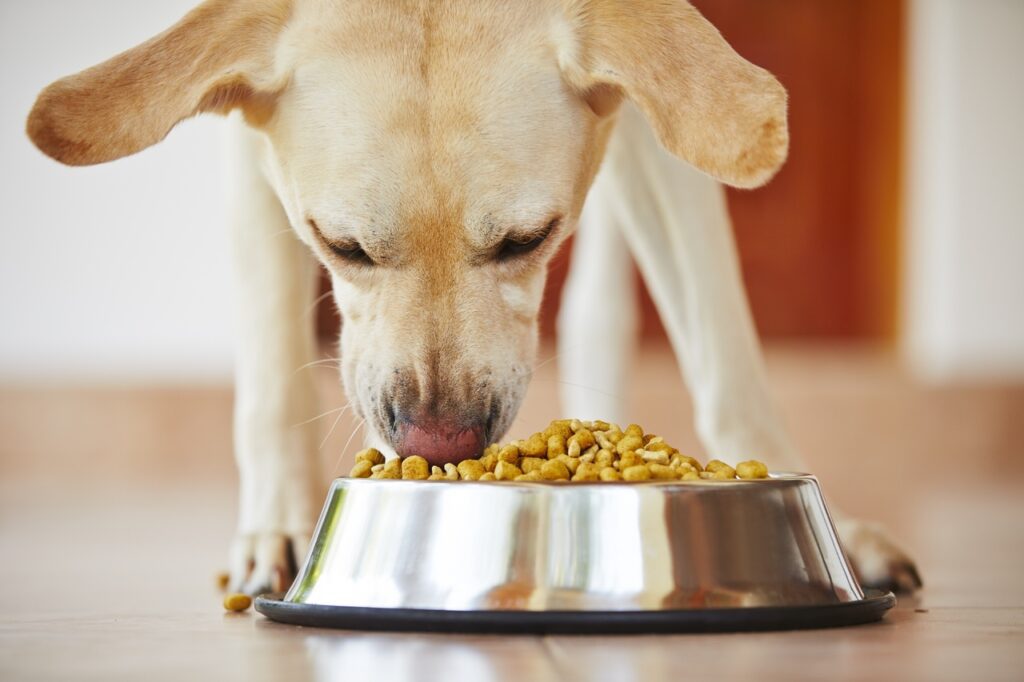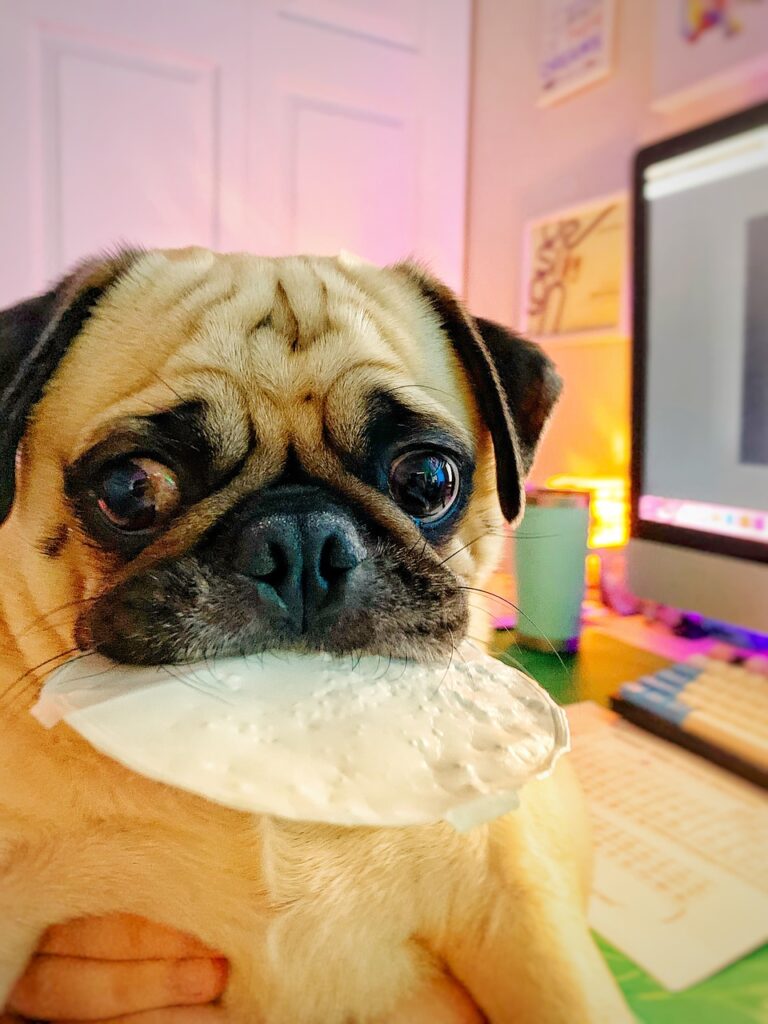Puppies are known for their enthusiastic appetites, but what should you do if your little furry friend is turning up their nose at solid dog food?
There could be a few different reasons why your puppy is avoiding their kibble, from teething pains to digestive issues.
In this article, we’ll explore some common reasons why puppies may avoid solid food and share tips to help encourage them to eat.
So whether you’re a first-time puppy owner or a seasoned pet parent, read on for some helpful advice on what to do when your puppies refuse solid food.
1. Gradual Transition

One of the best ways to help your puppy transition to solid food is to do it gradually. Start by mixing a small amount of dry dog food with their wet food.
Over time, gradually increase the ratio of dry food to wet food until your puppy is eating small pieces of dry kibble on their own.
It’s important to remember that puppies have sensitive digestive systems, so it’s essential not to rush their transition to solid food.
Giving your puppy time to adjust to a new diet will help reduce the chances of digestive upset. As a general rule, it’s best to start transitioning your puppy to solid food when they are around four weeks old.
If your puppy has had loose stools or diarrhea after eating solid food, it may be a sign that you’re transitioning too quickly. In this case, you should slow down the process and give your puppy more time to adjust.
Remember, every puppy is different, so it may take more or less time for your furball to get used to solid food. Be patient and persistent, and your puppy will learn to love their meals in no time!
See also: How To Care For a Newborn Litter of Puppies [Complete Guide]
What To Do When Puppies Refuse Solid Food
2. Ensure The Food Warm

Another essential step to take when your puppy refuses solid food is to make sure their food is warm. Puppies tend to prefer warm food over cold food.
If you’re feeding your puppy dry kibble, try adding a small amount of warm water to it before feeding. The warmth and moisture can make the food more palatable and appealing to your puppy.
You can also try warming up the wet food slightly before serving it to your puppy. A few seconds in the microwave can make all the difference! However, be careful not to overheat the food, as this can burn your puppy’s mouth and cause them to refuse food altogether.
By ensuring your puppy’s food is warm and inviting, you can increase the likelihood that they will eat it. And once your puppy takes that first bite, they’ll be more likely to continue eating the meal on their own.
What To Do When Puppies Refuse Solid Food
3. Soften The Food

If your puppy is still refusing solid food, you may want to try softening it. This is particularly useful if your puppy is experiencing teething pains and finds it difficult to chew on hard kibble.
Start by mixing a small amount of warm water with the dry kibble and let it sit for a few minutes. The water will soften the kibble and make it easier for your puppy to chew and digest.
You can gradually decrease the amount of water you use until your puppy is able to eat the kibble on its own.
Another option is to feed your puppy wet food instead of dry kibble. Wet food is already soft and moist, making it easier for puppies to digest. It may even be more appealing to your puppy’s taste buds than dry kibble.
Whether you choose to soften your puppy’s food or switch to wet food entirely, ensure that the food is still nutritionally balanced and appropriate for their age and size. Consult with your veterinarian if you have any concerns about your puppy’s diet.
What To Do When Puppies Refuse Solid Food
4. Choose High-quality Food
Choosing the right food is critical to ensure that your puppy is receiving the necessary nutrients for healthy growth.
Make sure you are providing high-quality dog food without any added fillers or artificial flavors. The optimal diet should be well-balanced and provide adequate protein, carbohydrates, vitamins, and minerals.
Consider speaking to your veterinarian, who can recommend high-quality puppy food based on your puppy’s age, breed, and health status.
Avoid giving your puppy table scraps or human food, as this can lead to nutritional deficiencies and health problems over time. Additionally, it can create bad eating habits and lead to picky eating behavior.
By choosing high-quality dog food, you can help ensure that your puppy is receiving the necessary nutrients for a healthy and happy life.
What To Do When Puppies Refuse Solid Food
5. Make It Tasty
Making your puppy’s food more appetizing can also help encourage them to eat. Try adding a small amount of high-quality wet food or chicken broth to the dry kibble. This can add an extra burst of flavor that can entice your puppy to eat.
You can also experiment with different types of treats and food toppers to add variety to your puppy’s diet and make mealtime more exciting.
Just make sure to choose healthy and appropriate options that are suitable for your puppy’s age and size.
Keep in mind that while making your puppy’s food tastier can be helpful, it’s important not to go overboard. Too many added treats or flavorings can lead to digestive upset or weight gain. Moderation is key when it comes to adding extra flavors to your puppy’s meals.
With a little bit of creativity and patience, you can find the right combination of flavors and textures to keep your puppy excited about eating solid food.
6. Feed at Regular Intervals
Feeding your puppy at regular intervals can help establish a routine and encourage healthy eating habits. Puppies generally require more frequent meals than adult dogs, so it’s recommended to feed them three to four small meals a day.
Try to establish a consistent feeding schedule with regular mealtimes. This can help your puppy anticipate when it’s time to eat and also promote better digestion.
This will also make it easier for you to monitor your puppy’s food intake and ensure they are eating enough to support their growth and development.
Keep in mind that feeding your puppy too late in the day can interfere with their sleep schedule, so aim to feed them their last meal a few hours before bedtime.
By feeding your puppy at regular intervals, you can establish a healthy eating routine and make mealtime a positive and enjoyable experience.
What To Do When Puppies Refuse Solid Food
7. Limit Distractions
When it comes to mealtime, puppies can be easily distracted by their surroundings. To help your puppy focus on their food, it’s essential to limit any distractions during meals.
Feed your puppy in a quiet, calm environment away from loud noises or other pets. Turn off the television or any other distractions in the room. Loud noises or activities can cause your puppy to become anxious and may distract them from their food.
Another way to limit distractions is to establish mealtime as a designated time for eating only. Refrain from giving your puppy treats or table scraps throughout the day or during their mealtime.
It’s important to maintain a consistent feeding schedule and avoid any disruptions that may interfere with your puppy’s eating habits.
By creating a peaceful and distraction-free environment during mealtime, you can help encourage your puppy to focus on their food and establish healthy eating habits.
8. Encourage Positive Association
Positive association with mealtime can go a long way in helping your puppy enjoy their food. One way to encourage positive association is by praising or rewarding your puppy when they finish their meals.
Verbal praise or a small treat can motivate your puppy to eat and also create a positive experience around mealtime.
Another idea is to make mealtime a bonding experience between you and your puppy. Sit with your puppy while they eat and offer gentle encouragement and affection. This can help create a positive and comforting atmosphere for your puppy while they eat.
You can also try feeding your puppy puzzles or toys that require them to “work” for their food. This can make mealtime more enjoyable and engaging for your puppy. These types of toys can also promote mental stimulation and help alleviate boredom.
By encouraging positive association with mealtime, you can help your puppy enjoy their food while also strengthening your bond with them.
9. Monitor Intake
It’s important to keep track of your puppy’s food intake, especially if they have been refusing solid food. Monitoring their intake can help you identify any potential health issues or identify if there is an underlying problem with their diet.
One way to monitor your puppy’s intake is by keeping a log of how much they eat at each meal. This can be helpful in identifying patterns or changes in their eating habits. You can also weigh your puppy regularly to ensure that they are growing at a healthy rate.
If you notice that your puppy’s food intake has decreased significantly or they are losing weight, consult with your veterinarian. They can perform a physical exam and recommend any necessary tests to rule out any health problems.
By monitoring your puppy’s food intake, you can ensure that they are getting the nutrition they need to grow and thrive. It’s also a great way to catch any potential health issues early on and ensure that your puppy is receiving the proper care and attention they need.
10. Rule Out Medical Issues
If your puppy is still refusing solid food despite your best efforts, it may be a sign of an underlying medical issue. Some health problems that can cause a loss of appetite in puppies include gastrointestinal issues, dental problems, and infections.
If your puppy’s refusal to eat continues for an extended period, it’s imperative to rule out any medical issues and schedule a visit with your veterinarian. They can evaluate your puppy’s overall health and recommend any necessary tests or treatments.
Your veterinarian may also provide recommendations on diet and feeding schedules that may help resolve the issue. It’s essential to follow their advice and work closely with them until your puppy’s appetite returns to normal.
By ruling out any medical issues, you can help address any underlying health problems and ensure that your puppy stays healthy and happy.
In Conclusion
In conclusion, it’s important to remember that puppies can be finicky eaters and may require some extra patience and attention.
However, by identifying the root cause of their refusal to eat solid food, you can take the necessary steps to address the issue and ensure your puppy is getting the nutrition they need to grow big and strong.
Whether it’s switching up their diet, offering smaller and more frequent meals, or adding some tasty supplements, there are many ways to help encourage your puppy to eat.
With a little bit of care and attention, you can get your little furball eating solid food again in no time!





Leave a Reply